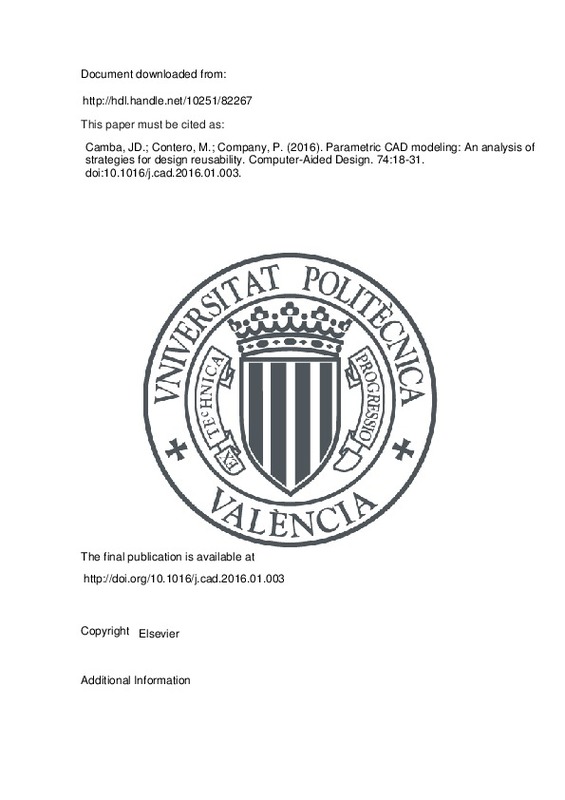JavaScript is disabled for your browser. Some features of this site may not work without it.
Buscar en RiuNet
Listar
Mi cuenta
Estadísticas
Ayuda RiuNet
Admin. UPV
Parametric CAD modeling: An analysis of strategies for design reusability
Mostrar el registro sencillo del ítem
Ficheros en el ítem
| dc.contributor.author | Camba, Jorge D.
|
es_ES |
| dc.contributor.author | Contero, Manuel
|
es_ES |
| dc.contributor.author | Company, Pedro
|
es_ES |
| dc.date.accessioned | 2017-06-02T12:17:26Z | |
| dc.date.available | 2017-06-02T12:17:26Z | |
| dc.date.issued | 2016-05 | |
| dc.identifier.issn | 0010-4485 | |
| dc.identifier.uri | http://hdl.handle.net/10251/82267 | |
| dc.description.abstract | CAD model quality in parametric design scenarios largely determines the level of flexibility and adaptability of a 3D model (how easy it is to alter the geometry) as well as its reusability (the ability to use existing geometry in other contexts and applications). In the context of mechanical CAD systems, the nature of the feature-based parametric modeling paradigm, which is based on parent-child interdependencies between features, allows a wide selection of approaches for creating a specific model. Despite the virtually unlimited range of possible strategies for modeling a part, only a small number of them can guarantee an appropriate internal structure which results in a truly reusable CAD model. In this paper, we present an analysis of formal CAD modeling strategies and best practices for history-based parametric design: Delphi's horizontal modeling, explicit reference modeling, and resilient modeling. Aspects considered in our study include the rationale to avoid the creation of unnecessary feature interdependencies, the sequence and selection criteria for those features, and the effects of parent/child relations on model alteration. We provide a comparative evaluation of these strategies in the form of a series of experiments using three industrial CAD models with different levels of complexity. We analyze the internal structure of the models and compare their robustness and flexibility when the geometry is modified. The results reveal significant advantages of formal modeling methodologies, particularly resilient techniques, over non-structured approaches as well as the unexpected problems of the horizontal strategy in numerous modeling situations. (C)2016 Elsevier Ltd. All rights reserved. | es_ES |
| dc.language | Inglés | es_ES |
| dc.publisher | Elsevier | es_ES |
| dc.relation.ispartof | Computer-Aided Design | es_ES |
| dc.rights | Reserva de todos los derechos | es_ES |
| dc.subject | CAD reusability | es_ES |
| dc.subject | Parametric modeling | es_ES |
| dc.subject | Modeling methodologies | es_ES |
| dc.subject | Design intent | es_ES |
| dc.subject.classification | EXPRESION GRAFICA EN LA INGENIERIA | es_ES |
| dc.title | Parametric CAD modeling: An analysis of strategies for design reusability | es_ES |
| dc.type | Artículo | es_ES |
| dc.identifier.doi | 10.1016/j.cad.2016.01.003 | |
| dc.rights.accessRights | Abierto | es_ES |
| dc.contributor.affiliation | Universitat Politècnica de València. Escuela Técnica Superior de Ingenieros Industriales - Escola Tècnica Superior d'Enginyers Industrials | es_ES |
| dc.description.bibliographicCitation | Camba, JD.; Contero, M.; Company, P. (2016). Parametric CAD modeling: An analysis of strategies for design reusability. Computer-Aided Design. 74:18-31. doi:10.1016/j.cad.2016.01.003 | es_ES |
| dc.description.accrualMethod | S | es_ES |
| dc.relation.publisherversion | http://doi.org/10.1016/j.cad.2016.01.003 | es_ES |
| dc.description.upvformatpinicio | 18 | es_ES |
| dc.description.upvformatpfin | 31 | es_ES |
| dc.type.version | info:eu-repo/semantics/publishedVersion | es_ES |
| dc.description.volume | 74 | es_ES |
| dc.relation.senia | 327106 | es_ES |
| dc.identifier.eissn | 1879-2685 |







![[Cerrado]](/themes/UPV/images/candado.png)

